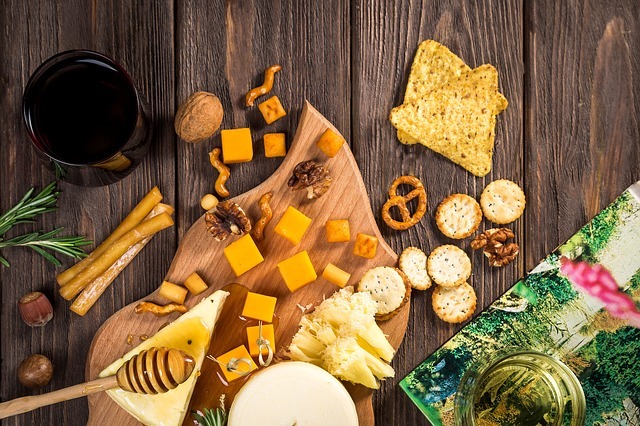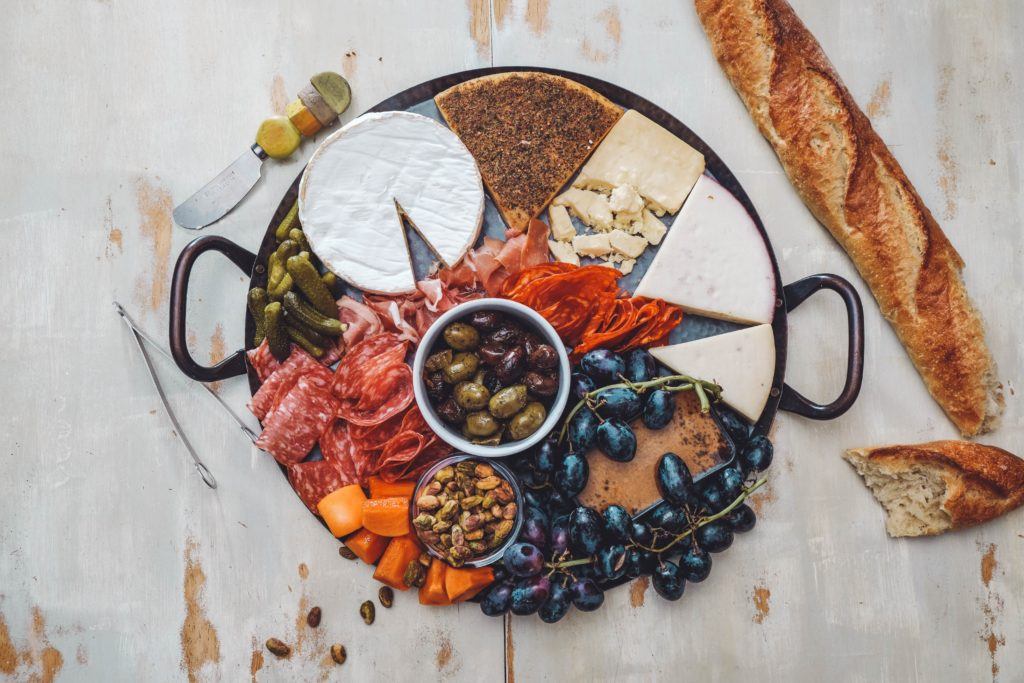Are you planning your next party, and trying to decide the best snacks to serve? Are you looking for something a little classier than a bowl of chips, but still easy to create and tasty for your guests to enjoy?
You should consider serving up a cheese platter! With a wide variety of flavors to please all of your guests, a cheese platter is a welcome addition to any gathering.
If you want to learn some cheese tray ideas that will help you create the perfect cheese platter for your event, then you’re in the right place!
Contents
What is a Cheese Platter?
A cheese platter is a large plate or tray with an assortment of cheeses on it. These cheeses may be sliced or cubed, or served in a dish for softer kinds of cheese.
The platter may also have different foods on it for you to eat along with the cheese, such as fruits, meats, crackers, or even chocolate.
Cheese platters are commonly found at parties, as an easy way for guests to serve themselves a tasty snack or hors d’oeuvre.
A cheese platter can range from simple to more elaborate, with however many kinds of cheese as you’d like to serve!
When to Serve a Cheese Platter
Cheese platters are deceptively elegant, considering how easy they are to assemble and serve.
When you have a range of taste preferences at your party, are on a budget, or lack the time to cook a large meal, the cheese platter is a classy and effective go-to.
If you have guests and they might be hungry (let’s face it, most people go to parties for the food) then you just can’t go wrong with a cheese platter!
Cheese Platter Ideas
There are many factors to consider when developing your cheese platter, from the kind of cheeses to serve, to the foods and drinks you should provide alongside the cheese, to the ultimate presentation of your cheese platter.
After all, these elements are the difference between a platter that’s cheap in quality or aesthetically brilliant while cheap on the budget!
Here are cheese platter ideas to ensure you create the perfect assortment for your next party.
Types of Cheese
There must only be a couple of dozen ways to make cheese… right? Wrong! There are more than two thousand varieties that we know of!
Among this wide world of cheese are several types, also known as “families.” Here are the four main types, separated by their hardness and moisture content.
- Soft cheeses, also called “soft-ripened,” are easily sliced through with a butter knife and will melt with only a small degree of heat. Soft cheeses include feta, camembert, and brie.
- The greatest number of cheeses are, in fact, semi-soft. This kind tends to be very mild in taste, and they have a higher moisture content than soft varieties. Semi-soft cheeses include mozzarella and havarti.
- Hard cheeses are those with a 50 percent level of moisture, which puts them right in the middle between soft and firm kinds. Examples of hard cheeses are romano, vintage gouda, and parmesan.
- Finally, the hardest type of cheese is called the “firm cheese.” Firm cheeses have a very low moisture level, resulting in a rather tough exterior compared to other kinds. Examples of firm cheeses include colby, gouda, friulano, cheddar, and provolone.
Best Cheeses for a Platter
Your best bet is to include as much variety in flavors and textures as you can.
If you can have at least one kind of cheese from each of the four categories listed above on the platter, then your guests will be in good hands!
Another idea for variety is to select cheeses that were made from different kinds of milk, such as cow milk, goat milk, and sheep milk. This will automatically create a range of flavors to suit anyone – and to accommodate dietary restrictions!
Also, keep your guests’ comfort in mind as you select the cheeses that you will serve them. As much as you might want to introduce them to the wide world of cheese with its thousands of kinds, people are far more likely to start with a kind of cheese they already recognize.
Be sure to include at least one familiar cheese on your platter! Once your guests have had their cheddar or mozzarella, then they may feel comfortable branching out into manchego, camembert, or gorgonzola.
This video shows an example of a great cheese platter.
What to Serve with Cheese
While you could develop a cheese platter with only cheese on it, a variety of flavors are better than just one alone. Fortunately, you have many options for excellent foods to serve on the platter!
From meat and fruit to crackers and chocolate, cheese goes very well with many of its neighbors across the food pyramid. Here are several foods you can pair with cheese for enhanced flavor!
Charcuterie
Charcuterie is a French word not only for cold cooked meats, but also for the French stores that sell these meats.
When selecting ones for your cheese platter, it’s wise to have an equal number of meats to your types of cheese, creating the best pairing options.
Two ounces of meat is a good portion, especially if it goes along with two ounces of cheese! But what kinds do you need?
Dry cured salami is a must-have for any cheese platter with meat, made from pork or beef and generally air-dried.
Italian meats are also a great addition to your platter. These meats can include prosciutto, an Italian dry-cured ham; soppressata, an Italian dry salami; and mortadella, an Italian sausage.
Bite-sized pieces of turkey, pork jerky, or beef are also great additions to your cheese platter, especially if you are concerned about your guests wondering what all those fancy meats with the multi-syllabic names are!
Fruit
Fruit and cheese are a natural pair, just as much as wine and cheese; wine is made from grapes, after all, which are a kind of fruit!
Most cheeses will go perfectly well with most fruits, but there are a few specific pairings that work better than others.

For example, peaches go well with mozzarella, mango goes well with goat cheese, and strawberries or strawberry jam go well with fontina.
Apples go well with different kinds of cheese, depending on how sweet or tart they are. More tart apples go best with gouda cheese, while sweeter apples tend to pair wonderfully with cheddar or a milder cheese.
If you’re feeling adventurous, supplying all those kinds for guests to mix and match is a great conversation starter!
Though most fruits pair excellently with cheese, be sure to keep the more potent citrus fruits far away from your platter. This includes fruits such as grapefruit, lemons, tangerines, or limes.
The citrus will alter the taste and smell of the cheese in negative ways and may leave your guests wary of the platter.
Crackers
The cheese and cracker tray is a traditional favorite in any party. Cheese and crackers just plain go together, and for many people, the phrase comes to mind just as quickly as “peanut butter and jelly.”
While a plain cracker will absolutely suffice, browsing the selections at your local market can provide you with unique taste combinations that’ll wow your guests.
You may even consider making your own – but here are some suggestions for ideal cracker choices.
- Croccantini are small, thin, and crunchy crackers that go well with all types of cheese.
- Oat biscuits, a Scottish cracker, have an oaty, sweet flavor that pairs excellently with soft cheeses like goat and triple crèmes; they also go well with a harder cheese such as cheddar.
- Spanish torta crackers are usually flavored with sugar, olive oil, and a touch of anise. Tortas go deliciously with soft, mild cheeses like brie or camembert, and also with more flavorful cheeses such as monterey jack or manchego.
- The Water Wheel is an airy, wafer-thin Australian cracker without much flavor of its own; rather, it allows the cheese to be the main event. If serving Water Wheels, use a cheese knife to avoid splitting this thin cracker.
- Urban Oven Crackers are thicker and with a flavor of olive oil, and they go very well with aged cheeses, including gouda, comte, gruyere, and cheddar.
If you already have various fruits on your cheese platter, you may want to avoid using crackers that have a strong garlic or onion flavor.
The fruits bring with them enough interesting flavors, so adding more through a cracker may be too stimulating for your guests’ taste buds.
Chocolate
Have you ever been asked to choose between your love of chocolate and your love of cheese? What if you didn’t have to choose a favorite?

Chocolate and cheese are fantastic to pair together! Here are some examples of excellent cheese and chocolate pairings.
- Gouda cheese and coffee-flavored chocolate go well together, creating an interesting combination of the bitter coffee and the sweet cheese.
- For a cheese with a more intense flavor, such as goat cheese, add milk chocolate to your platter to balance out the tastes.
- Cheddar cheese is often described as “nutty,” which may be why it goes so well with chocolate full of nuts.
- Blue cheese and dark chocolate are a surprising pair; if your friends claim to not like one or the other, they may still enjoy the taste of them together!
- And if you have brie cheese on your platter, provide some chocolates with fruit fillings to get the most of three excellent pairings – chocolate with cheese, chocolate with fruit, and cheese with fruit!
Wine Pairings with Cheese
Cheese is universally known as a great match to wine, and most wine tastings will include it on the snack menu.
The textures and flavors complement each other and balance out your pallet in unique ways. As such, you can’t go wrong by serving wine alongside your cheese platter!
This video shows a creative way to add chocolate to your cheese platter.
What Wines Go Best With Different Cheeses?
- For bleu cheese, add some port wine; the sweetness is an ideal foil for the pungent cheese.
- Parmesan and prosecco are an Italian cheese and wine that pair delightfully; the bubbles in the proscetto mix well with the saltiness of the cheese.
- Sauternes is a rich dessert wine, so it only makes sense to serve it alongside an equally rich cheese fondue.
- Aged gouda has a strong, nutty flavor, which requires a full-bodied, tannic wine to stand up to its taste. Cabernet Sauvignon is a great match for gouda cheese!
- Classy Chardonnay goes wonderfully with gruyere, bringing both fruit and nut flavors to compliment the flavor of the cheese.
If you already know what kind of cheese or wine you enjoy, don’t risk pairing them inappropriately! Be sure to do an internet search for matches, so you can have confidence the taste will be exceptional.
Cheese Platter Presentation Ideas
Now that you know which varieties will find a home on your platter, it’s time to consider how to arrange and serve these snacks.
Your cheese platter presentation is just as important as your food options!
No Cross-Contaminating!
Try to keep strong-smelling cheeses away from the other kinds, so their scent does not overpower the more delicate types of cheese.
Also, set out a separate knife for each cheese you serve, especially for any soft cheeses, to avoid unwanted flavor mixes that could ruin the entire batch.
Firm cheese may also require a paring knife in order to be easily served.

Organizing and Labeling
If you have a larger spread of cheese platters, place the trays on several different tables. This allows your guests more room to move around and explore the different varieties without crowding each other.
Finally, consider labeling each cheese so that your guests know what they are testing without having to ask you over and over again!
You can also include a few descriptions on each label to explain the cheese’s flavor, and a word or two about what fruits or wines that your guests should try them with.
Now you know how to create the perfect cheese platter for your next party!
What’s your favourite cheese platter combination?






